Early Establishment of Industrial Hemp (Cannabis sativa L.) Increases Yields in the Mid-Atlantic
Erin Myers, Master’s Student, and Nicole Fiorellino, Assistant Professor & Extension Specialist Department of Plant Science and Landscape Architecture, University of Maryland, College Park
Introduction
Planting dates are well established for crops such as corn and soybean to maximize yield and quality, but production guidance is lacking for industrial fiber hemp (Cannabis sativa L.), especially in the Mid-Atlantic region. With fiber hemp production increasing since the passing of the 2014 and 2018 US Farm Bills, we need to understand how it can fit into current crop rotations, by determining appropriate planting and harvest dates to support yields. We performed the present study to develop production recommendations for hemp produced for fiber in Maryland.
Methods
The two-year study was performed at two University of Maryland Research and Education Center, Wye Research and Education Center (WREC) in 2022 and 2023 and at Upper Marlboro (CMREC) in 2023. We utilized a split plot, randomized complete block design with planting date as main plots and either variety or harvest date as split plots (Figure 1).
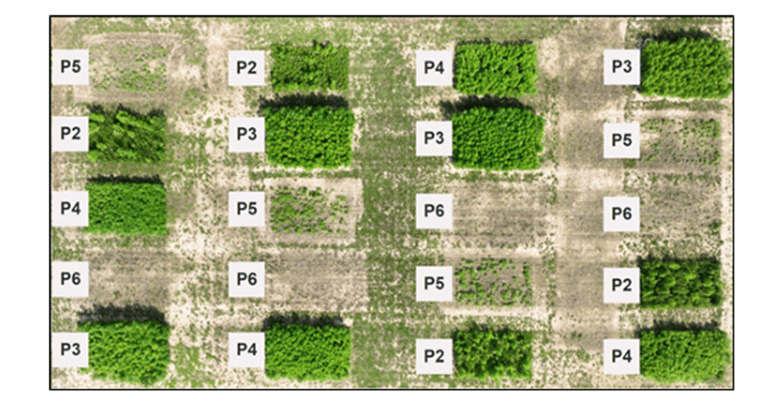
In 2022 at WREC, we established plots at five planting dates, using two hemp varieties (Bialobrezkie and Yuma), and one harvest timing, at the onset of flowering (Table 1). Seed was planted via grain drill into prepared seed beds, every three weeks, starting in April and ending in July, with a target seeding rate of 35 lbs of live seed per acre. Modifications were made to the study design in 2023 based on lessons learned in 2022, namely, the poor performance of Bialobrzskie led to its removal the following year. In 2023 at both WREC and CMREC, we established plots at six planting dates, using only the Yuma variety, and two harvest timings: Harvest 1 occurred 90 days after each respective planting date, with Harvest 2 representing a full season harvest, as all planting dates were harvested at the same time, at the onset of flowering (Table 1).
At the time of each harvest in both years, average plant height and stalk diameter were measured from 10 plants from each plot, followed by fresh weight of the entire harvested plot. Due to establishment errors in 2023, namely poor germination of carryover seed and excessive seeding rate with new seed, some planting dates were removed from statistical analysis (Table 1).

Table 1. Planting dates for Wye 2022 and 2023 and UM 2023. In 2023, Harvest 2 was 25 September for all plots at both locations. †90 d growing season for PD 6 at Wye in 2023 coincided with harvest during Harvest 2, therefore no Harvest 1 data was collected; ‡ Data collected from these treatments were removed from statistical analysis due to use of carryover seed with poor germination or incorrect seeding rate.
Results
Harvest 1 results represent a “short season” fiber hemp crop, while Harvest 2 represents a “full season” fiber hemp crop, with results presented separately herein for the two harvests.
Fresh Yield
For Harvest 1, where all plots were harvested after a 90 d growing season, fresh yield was significantly impacted by the interaction between plant date and site-year (p = 0.0293). Short season hemp performed best at CMREC, with earlier plantings there yielding the best, with early plantings at WREC following with good yields. These data suggest that photoperiod plays an important role in fiber hemp yields (Table 2). Given the removed data from the earlier plantings, more research is needed to support the recommendations of a shortened growing season.
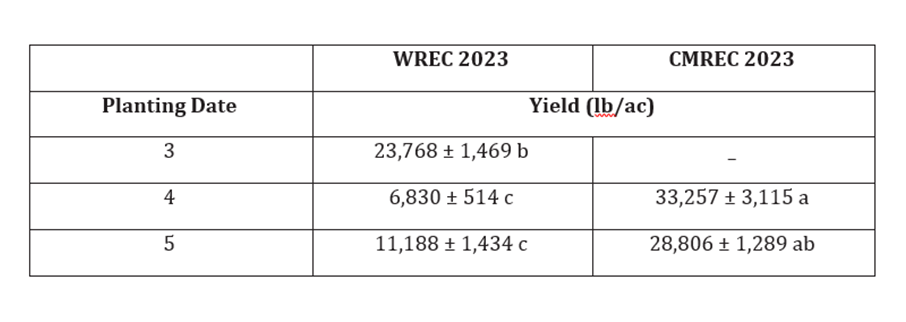
Table 2. Mean fresh hemp yield and standard error for each planting date by location for Harvest 1
For Harvest 2, where all plots were harvested near the onset of flowering regardless of planting date, planting date (p < 0.0001) and site year had significant impacts (p < 0.0001) on fresh yield. CMREC in 2023 and WREC 2022 yielded similarly, with significantly decreased yields at WREC in 2023. Data supported that earlier planting dates had increased yields for the Harvest 2 data (Figure 2). Significant decreases were seen after the early June planting date, supporting a viable full season planting range of late April to early June, allowing for flexibility when planting this crop.
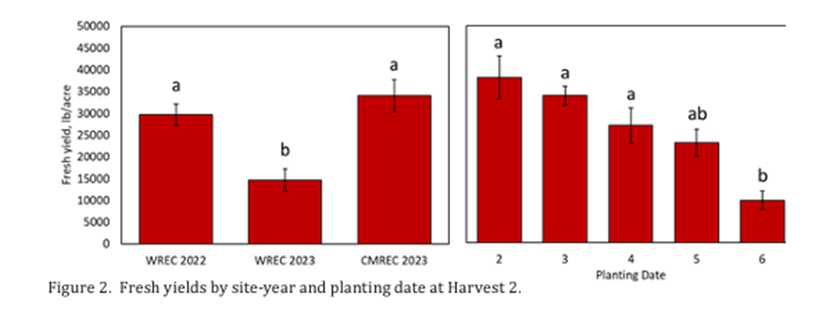
Height and Diameter
Neither planting date or site-year significantly impacted plant height or stalk diameter at Harvest 1 (90 d growing season), indicating the shorter growing season is not long enough to maximize height or diameter. At Harvest 2, site-year and planting date significantly impacted plant height (p < 0.0001 and p = 0.0005, respectively). Similar to yield, the shortest plant height was observed at WREC in 2023 and plant height decreased across planting dates but remained relatively constant after the mid-season planting (Figure 3).
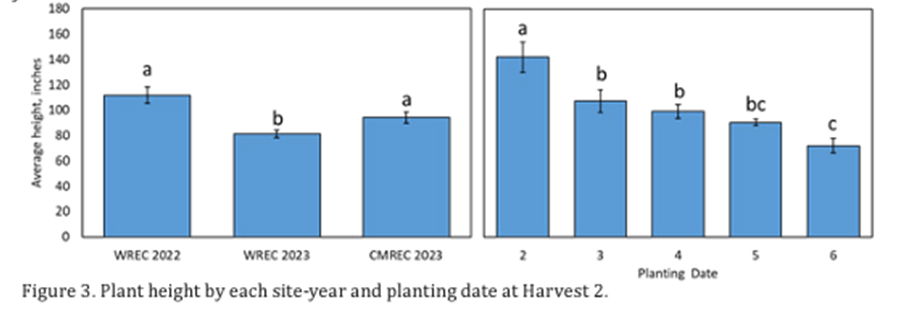
At Harvest 2, planting date only significantly impacted stalk diameter (p = 0.0020), with stalk diameter decreasing across planting dates, but leveled off in the later dates (Figure 4). Different end-product industries using fiber hemp will have material specifications that are optimal, which means the impact of planting date on both height and stalk diameter in the present study is not positive or negative. But the effect of planting date on these two plant characteristics indicates management, such as planting date, can be manipulated by farmers to generate hemp that meets industry specifications once they are defined for a specific industry.
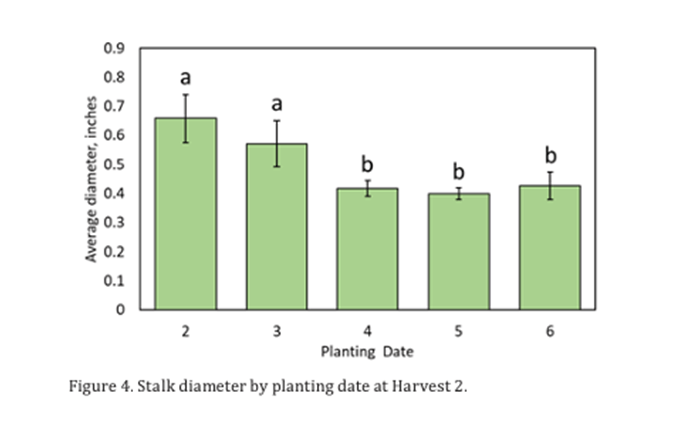
Conclusions
Results from this study support that early planting dates increase fresh yield, plant height, and stalk diameter of industrial hemp produced for fiber in Maryland. Fiber hemp should be planted between mid-April and mid-June, recognizing that the photoperiod sensitivity of the crop induces flowering around mid-September. Additionally, it is important to recognize that hemp is not an irrigated crop and drought conditions may negatively impact germination and, ultimately, yield. To incorporate fiber hemp into our current corn, soybean, and small grains rotations in Maryland, it is recommended that fiber hemp be managed as a full season crop to maximize yield and plant characteristics. Future research should focus on an intermediate harvest timing, that results in a growing season longer than 90 days with a harvest prior to hemp transition to reproductive growth; this would likely result in hemp harvest prior to corn or soybean harvest. This study and future research investigating an intermediate harvest timing will provide better guidance to farmers interested in growing fiber hemp as part of their current crop rotation.